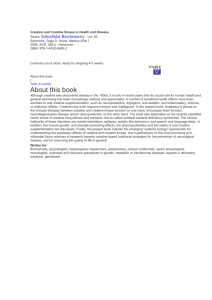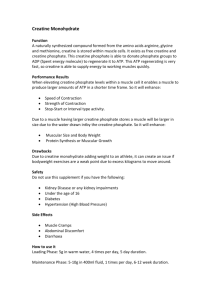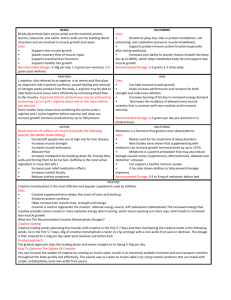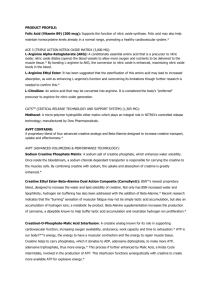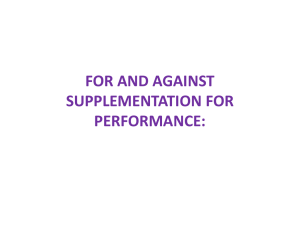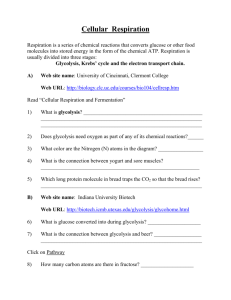Creatine Creates Controversy
advertisement
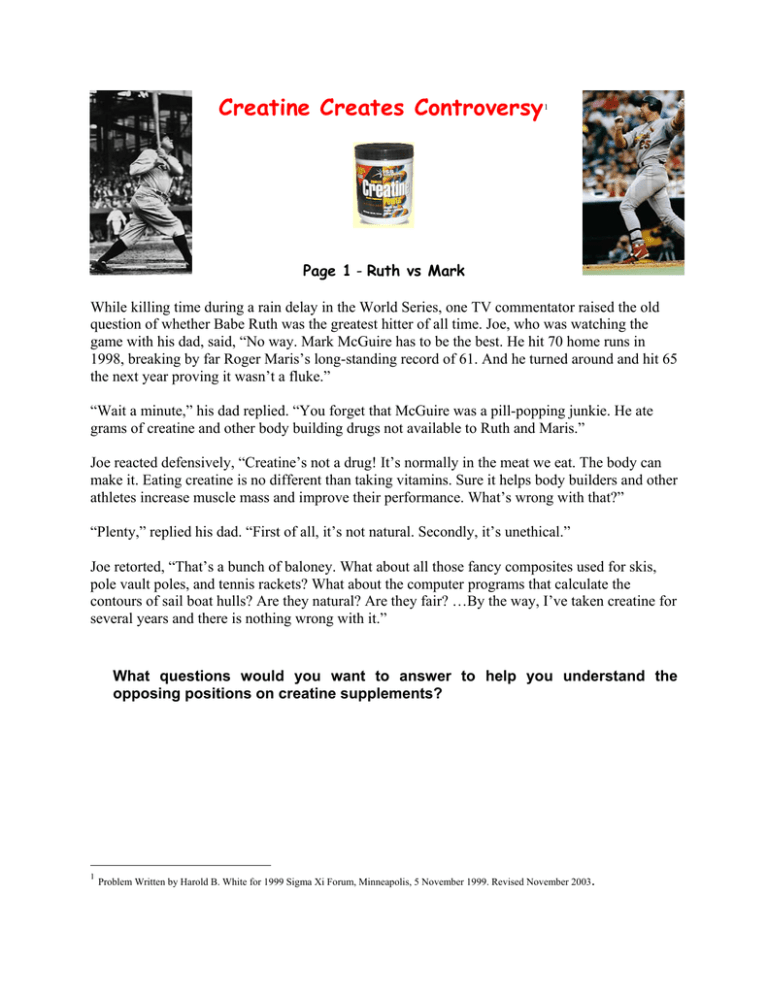
Creatine Creates Controversy 1 Page 1 - Ruth vs Mark While killing time during a rain delay in the World Series, one TV commentator raised the old question of whether Babe Ruth was the greatest hitter of all time. Joe, who was watching the game with his dad, said, “No way. Mark McGuire has to be the best. He hit 70 home runs in 1998, breaking by far Roger Maris’s long-standing record of 61. And he turned around and hit 65 the next year proving it wasn’t a fluke.” “Wait a minute,” his dad replied. “You forget that McGuire was a pill-popping junkie. He ate grams of creatine and other body building drugs not available to Ruth and Maris.” Joe reacted defensively, “Creatine’s not a drug! It’s normally in the meat we eat. The body can make it. Eating creatine is no different than taking vitamins. Sure it helps body builders and other athletes increase muscle mass and improve their performance. What’s wrong with that?” “Plenty,” replied his dad. “First of all, it’s not natural. Secondly, it’s unethical.” Joe retorted, “That’s a bunch of baloney. What about all those fancy composites used for skis, pole vault poles, and tennis rackets? What about the computer programs that calculate the contours of sail boat hulls? Are they natural? Are they fair? …By the way, I’ve taken creatine for several years and there is nothing wrong with it.” What questions would you want to answer to help you understand the opposing positions on creatine supplements? 1 Problem Written by Harold B. White for 1999 Sigma Xi Forum, Minneapolis, 5 November 1999. Revised November 2003. Creatine Creates Controversy Page 2 – Other Creatures Creatine (Cr) plays an important role in muscle metabolism where, as phosphocreatine (PCr), it enables the rapid production of ATP for muscle contraction before the mobilization other sources of energy. This source of energy lasts about 10 seconds, barely enough for an Olympic 100 meter sprint. When muscles need ATP, the enzyme creatine kinase transfers the phosphoryl group from phosphocreatine to ADP generating ATP. In resting muscle, the concentration ratio of creatine to phosphocreatine is about 0.6. COO COO H3N C H CH2 H3N C H CH2 ADP CH CH2 ATP 2 CH2 CH2 HN H2N C HN Arginine Kinase NH2 Arginine HN C NH2 PO3H Phosphoarginine Interestingly, many organisms do not have creatine in their muscles. For instance, insects use arginine in place of creatine and other guanidinium compounds, known as phosphagens, are found in mollusks and worms. Members of the phosphagen kinase enzyme family, to which creatine kinase belongs, often have the ability to phosphorylate related compounds. Supplementing animal diets with unnatural chemical analogs of creatine provides insights into the biochemistry and physiology of creatine metabolism. Turner & Walker (1984) [J. Biol. Chem. 262, 6605-6609] showed that chicks fed cyclocreatine (cCr) accumulated up to 60 mM phosphocyclocreatine in breast muscle and Wiseman & Kushmerick (1995) [J. Biol. Chem. 270, 12428-12438] determined the equilibrium constant in vivo. Annesley & Walker (1977) [Biochem. Biophys. Res. Comm. 74, 185-190] showed that muscle creatine kinase hardly discriminates between creatine and the unnatural analog cyclocreatine. They studied the following equilibrium in vitro and generated the data in the table below. Expt. No. 1 2 3 Conditions Initial Final* Initial Final* Initial Final* Substrate PCr mM 40 6 0 7 35 11 cCr mM 40 7 0 6 35 13 Cr mM 0 31 40 30 35 59 PcCr mM 0 32 40 36 35 60 * 6-8 hours at 37°C in the presence of trace amounts of MgATP and creatine kinase. Come to the next class prepared to discuss each of the following questions. 1. What is the equilibrium constant for the reaction above? 2. Why is MgATP necessary for the reaction and why only in trace amounts? 3. How much more or less is the free energy of hydrolysis of phosphocyclocreatine than phosphocreatine? 4. If the ratio of [PCr]/[Cr] in resting muscle is 3/2, what would you expect the ratio of [PcCr]/[cCr] to be in the muscles of birds fed cyclocreatine? 5. Considering the role of creatine in muscle and ignoring ethical issues and possible toxicity, what are the implications for athletic performance for a person who might consume cyclocreatine in place of creatine? Creatine Creates Controversy Page 3 - Creating Creatine The argument Joe had with his father got him thinking more about creatine and whether the effects on him were real or imagined. For example, he got to wondering whether vegetarians, who get no creatine in their diet, were athletically compromised compared to people who ate meat. In fact, he knew that several members of the women’s cross country team were vegetarian and they seemed to do well without meat or creatine supplements. Did these runners have less creatine in their muscles than other runners? Perhaps their bodies compensated and over produced creatine? How was the synthesis regulated? Might there be a difference in the effects of creatine depending on the sport? He was also puzzled by the fact that there was creatine in the brain. He had heard some members of the football team disparagingly called muscleheads by a physics professor, but he was sure something else was implied. While surfing the web for information on the biosynthesis of creatine, Joe found a biochemistry exam posted that contained the following problem: “Our bodies are perfectly capable of synthesizing creatine from compounds you know. From the two step pathway outlined below, provide the names of the precursors (A and B) whose structures are given and predict the structure of the intermediate (C) and byproduct (D) in the pathway. What would be the fate of D?” 1. Answer the exam question above. Justify your predictions. 2. What more about this pathway would be important to know? Creatine Creates Controversy Page 4 – Unspeakable Problems His curiosity about creatine in the brain where there were no muscles, led Joe to the medical literature which contained descriptions of several children who apparently have little or no creatine in their brain. They are mentally retarded and have severe language impairment. However, there are differences among them as indicated by the information below. • This infant boy had extremely low creatine concentrations in serum and urine as well as in muscle. In vivo magnetic resonance spectroscopy analysis showed a generalized depletion of creatine in his brain as well. Feeding arginine resulted in an increase in brain guanidinoacetate, but not creatine. Dietary creatine resulted in increased creatine and decreased guanidinoacetate in the brain, Stöckler et al. (1994) [Pediatric Research 36, 409-413]. A four year old girl with similar symptoms excreted large amounts of guanidinoacetate (~10X normal) in her urine, Schulze et al. (1997) [Journal of Pediatrics 131, 626-631]. • These two young mentally retarded sisters had severe language delay. Magnetic resonance showed no detectable creatine or guanidinoacetate in their brains and an intracellular pH of 7.24 compared to 7.07 in normal brain cells. They had normal levels of creatine in their serum and in muscles. They excreted normal amounts of creatine and very low amounts of guanidinoacetate. Feeding large amounts of creatine eventually resulted in near normal brain creatine levels, Bianchi et al. (2000) [Annals of Neurology 47, 511-513]. • This male child had elevated serum creatine levels (75 μmol/L vs 15-44 μmol/L) and elevated excretion of creatine but no detectable creatine in his brain. Creatinine excretion was normal. Dietary supplementation with creatine had no effect on brain creatine levels, Cecil et al. (2001) [Annals of Neurology 49, 401404]. Identify the likely metabolic defect in each case. References Annesley & Walker (1977) [Biochem. Biophys. Res. Comm. 74, 185-190] Bianchi et al. (2000) Reversible brain creatine deficiency in two sisters with normal blood creatine levels. Ann. Neurology 47, 511-513. Cecil et al. (2001) Irreversible brain creatine deficiency with elevated serum and urine creatine: a creatine transporter defect? Ann. Neurology 49, 401-404. See also Am. J. Hum. Genetics 68, 1497. Schulze et al. (1997) Creatine deficiency Syndrome caused by guanidinoacetate methyltransferase deficiency: Diagnostic tools for a new inborn error of metabolism. J. Pediatrics 131, 626-631. Stöckler et al. (1994) Creatine deficiency in the brain: a new, treatable inborn error of metabolism. Pediatr. Res. 36, 409-413. See also Am. J. Hum. Genetics 58, 914 (1996) and Pediatr. Res. 36, 409 (1996). Turner & Walker (1984) [J. Biol. Chem. 262, 6605-6609] Wiseman & Kushmerick (1995) [J. Biol. Chem. 270, 12428-12438]
